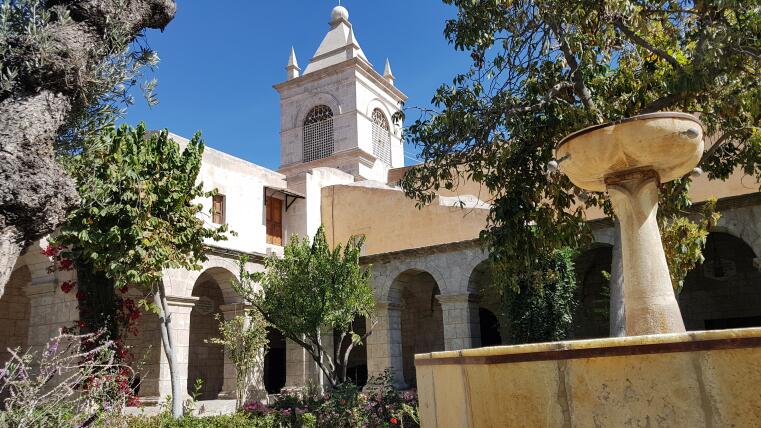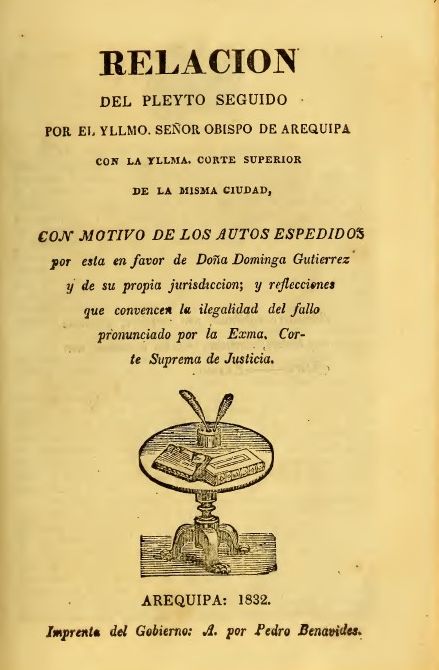“Standardisation was never a goal of the Peruvian liberal legislator”
Interview with Armando Guevara Gil on the legal history of Peru and the potential of micro-historical analyses

In 1821, Peru gained independence from the Spanish colonial empire. Despite the new legal codes issued in the young republic, the country was still shaped by a historically evolved legal pluralism. The legal anthropologist and historian Armando Guevara Gil takes a micro-historical approach to modern Peruvian legal history. He examines the phenomenon of runaway nuns in the early 19th century – cases on the intersection between secular and church law. In the interview, he comments on the state of Peruvian legal-historical research and argues in favour of paying attention to the microcosm of the individuals’ perceptions and agency.
Dr Guevara Gil, you investigate 19th century Peru with regard to legal pluralism – why did you think it was worthwhile to conduct your research at the Käte Hamburger Kolleg in Münster?
I think it was worthwhile because the Kolleg provides a rich intellectual environment for the diachronic study of legal pluralism. The directors and researchers are all involved in research projects that explore the tension between legal centralisation and standardisation, on the one hand, and the continuous tendency towards plurality and fragmentation, on the other. Of course, these processes do not occur mechanically or automatically, because historical outcomes are always contingent. So, what is challenging and interesting is to compare them beyond their chronological and spatial specificities. At the Kolleg, this is possible precisely because each of us is studying a different topic from different disciplinary perspectives, be it legal history, history, or anthropology. As a result, the interdisciplinary dialogue has been quite challenging, rewarding, and fruitful.
For my own take on legal pluralism, this learning experience has significantly raised my awareness about the dialectics between legal standardisation and pluralism as an unfolding historical process. For me, the lesson is that one can emphasise the study of one aspect of this trend but should not ignore the other. Only in this way, will we gain a better understanding of our research topics. Finally, I want to stress that it was worthwhile coming to the Kolleg because I found the most kind, humane, and amazing group of scholars one could ever imagine. They are not only world-class researchers, they are wonderful people and I thank them for sharing with me their ideas, ideals, and friendship.
What methodological or practical challenges does one face when dealing with Peruvian legal history?
In practical terms, the main challenges are the state of the archives and the lack of funding for researching legal history. It is unfortunate that a country with such rich documentary heritage is unable to safeguard it. Organising a national network of archives and repositories to preserve this legacy would also be a way to attract researchers, both national and international. Maybe in this way, Peruvian legal history will start to be included in the comparative map of the discipline. Currently, the contrast with the development of legal history in Europe or the USA is stark. And, in comparison with other Latin American countries like Mexico, Colombia, Chile, Argentina, or Brazil, Peruvian legal historiography is lagging way behind.
Within Peruvian academia, the challenges are enormous. After the brilliant scholarship of Jorge Basadre, Fernando de Trazegnies, Luis Pásara, and Carlos Ramos, over the last eighty years, no disciples have followed their lead. Part of the problem is that legal history is not an obligatory course in law schools due to the so-called modernisation of legal education. This conceptual mistake costs us dearly. There is no demand for specialists in the field and very few students take course or become interested in it. The consequence is that research by professors or students becomes a quixotic endeavour. As one can imagine, without a vibrant epistemic community, no significant theoretical and methodological progress is possible. Moreover, Peruvian and Peruvianist historians do not pay much attention to the legal dimension of social life. The lack of innovative theoretical and methodological approaches to 19th century Peruvian legal history creates a blind spot in current Peruvian historiography.
"Each court applied a different legal corpus"
After Peru's declaration of independence, various legal codes emerged in the young nation, which have so far been primarily described in research as an expression of centralisation and standardisation of law. What do you think of this interpretation?
I think it is a superficial assessment of the evolution of Peruvian law during the 19th century. The Civil, Commercial, and Criminal codes issued around mid-century are examples of pouring old wine into new wineskins. The Civil Code of 1852, for instance, supposedly follows the liberal ideals of the Napoleonic Code of 1804 and represents a radical break with Spanish colonial laws. But, in fact, it adhered to Las Siete Partidas de Alfonso X (1256-1265) and the peninsular Novísima Recopilación of civil law of 1805. Moreover, it has been called a condensation of the Ius Commune. For example, the section on personhood adopts a status-based classification using Roman, Canonical, and Castilian laws. Thus, clerics enjoyed a special status and jurisdiction with different time, space, and behavioural regulations, including one that bound them to civil death, with no property or contractual rights, while remaining sacred persons.
In quite different terms, slaves were also comprised in the legal classification of persons. Although slavery was abolished two years later in 1854, the inclusion of this category reveals the endurance of old laws and customs in which normative pluralism was predominant, given the power conferred on masters to organise and rule the lives of their slaves.
Marriage is also a clear example of the incorporation of the traditional normative framework that far exceeded the short life of the new liberal contractual order: “Marriage is celebrated in the Republic following the formalities established by the Church in the Council of Trent”, sanctioned the 1852 Civil Code. In this matter, it is interesting to observe that centralisation and standardisation were never a goal of the Peruvian liberal legislator. Quite the contrary, jurisdictional multiplicity and legal pluralism were the rule. While ecclesiastical courts adjudicated cases of annulment and canonical divorce; civil judges dealt with disputes over betrothal, alimony, childcare, legal fees, and the return of property; criminal courts meanwhile resolved cases of adultery, injuries, and offences. Needless to say, each one applied a different legal corpus.
Finally, property relations are another field in which the Civil Code offers examples of diverse regulatory regimes operating simultaneously and at odds with the liberal precepts of the Napoleonic Code that attempted to consolidate and unify ownership rights. In addition to the typical form of consolidated liberal property, the code regulated three forms of dismembered ownership (e.g., emphyteusis) based on the distinction between dominium directum (ownership) and dominium utile (possession, use and enjoyment). In short, the idea that the liberal codes promulgated during the 19th century were the flagships of normative monopolisation and standardisation is untenable. In the sociolegal humanscape of the time, it was impossible for the new liberal nomos to efface by fiat lux an enduring and deeply ingrained legal culture characterised by complexity and multiplicity.

In your current research project, you investigate the fascinating fate of a nun who wants to leave her convent. Could you summarise the case of Sister Dominga in a few sentences?
I study the lives and deeds of monjas cimarronas (runaway nuns) in early 19th century Peru. My objective is to assess the impact of liberal law on their efforts to challenge Church law, free themselves from their perpetual vows, and start a secularised life. Of all these cases, the one of Dominga Gutierrez de Cossio is the most dramatic. She entered a convent in 1821 at age 16, in Arequipa, Peru. In 1831, after being refused to renounce her perpetual vows, she escaped in a spectacular fashion. With the help of her servants, she smuggled a female corpse into her cell, set a fire that disfigured the face, and sought refuge at her uncle´s estate. When her fellow nuns found the burned body, they mourned and buried “Dominga”. But the truth was discovered soon. Dominga was not dead but alive and well, though she would be fatally stigmatised for the rest of her life. Her deeds sparked several legal battles between the secular and ecclesiastical authorities, to the point where both the Supreme Court of the young republic and the Roman Pope adjudicated her lawsuits. In the secular forum, the municipal authorities of Arequipa challenged the authority of the local Bishop, demanding civil protection of her freedom. While the regional court ruled in favour of the municipality, in the end, the Peruvian Supreme Court decided that the Bishop had full authority over Dominga. This was, as the documentation reveals, a political ruling to avoid confronting the Catholic Church. Even though the liberal reforms weakened it, the Church was still a formidable political and ideological actor. In the ecclesiastical forum, the Bishop charged Dominga with apostasy but almost immediately pardoned her and granted her uncloistering and secularisation. The final step, the nullification of Dominga´s perpetual vows was authorised by Rome in 1839. By that time, however, she had already moved to Lima to avoid the social stigma in Arequipa, was engaged with a physician, and lacked the will and means to pursue this final step. So, she had to live in a liminal state for the rest of her life. What is fascinating to document in this case is how Dominga and her legal and political advocates maneuvered within the normative plurality and jurisdictional complexity of early 19th century Peru, a sociolegal context that was just starting to abandon the old colonial nomos.

To what extent do microhistorical analyses of such individual cases provide new insights for legal history?
I think microhistorical analyses are a great avenue for expanding our understanding of legal history. They provide a glance into people´s experience with the law, courts, and institutions, as understood in the broadest possible sense. Zooming in on a single event, practice, or performance, to conduct an intensive investigation brings to light the social life of law, people´s perception of a given nomos, the human dramas processed by the law, and the agency actors deploy to navigate their legal world. The important thing to keep in mind is that to go beyond chronicling charming anecdotes or writing purely thick descriptions, micro-historians also have to address the broader questions concerning their discipline, in this case, legal history. Ideally, the depiction of a small topic will be representative of the totality we wish to understand. In any case, it at least provides hints of the multiple dimensions of the legal world we explore. In the end, the micro-cosmos is as complex as the macro-cosmos and we still do not fully understand either. This is why the tension between micro-history and grand narratives becomes very fruitful for the advancement of legal history.
The questions were posed by Emily Todt.

